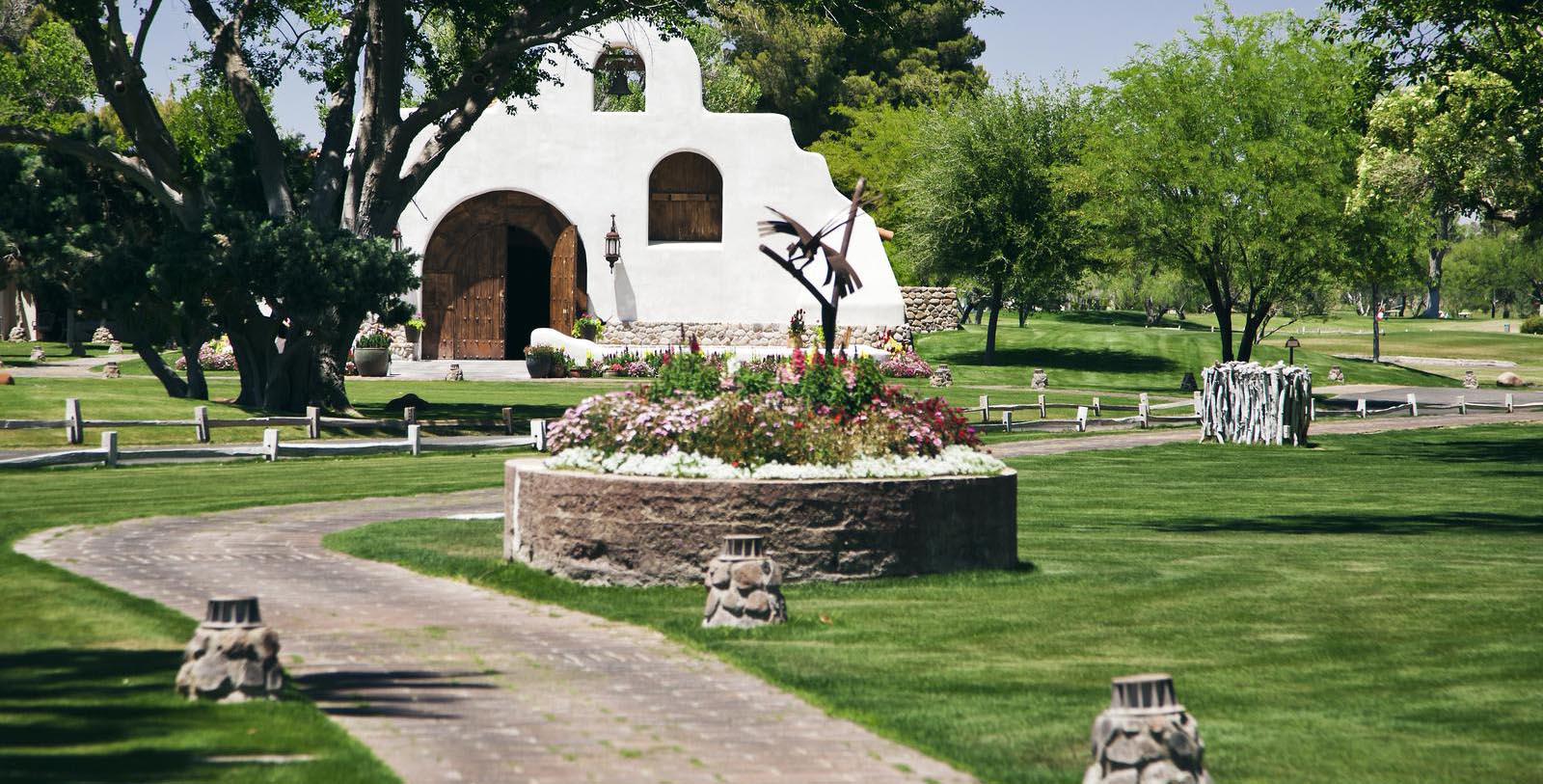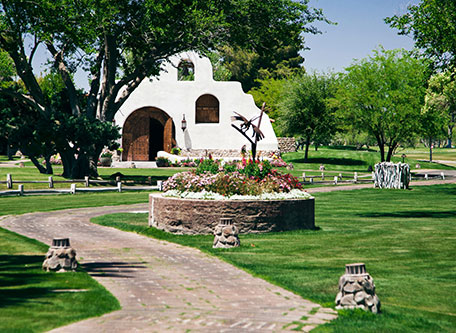Receive for Free - Discover & Explore eNewsletter monthly with advance notice of special offers, packages, and insider savings from 10% - 30% off Best Available Rates at selected hotels.
history
Discover the Tubac Golf Resort and Spa, which was once a massive cattle ranch owned by the prominent Otero family.
Tubac Golf Resort and Spa, a member of Historic Hotels of America since 2008, dates back to 1959.
VIEW TIMELINEThe history of the Tubac Golf Resort and Spa harkens back over four centuries to a young man named Don Toribio de Otero. The Spanish monarchy had granted Otero the first land grant in the territory of Pimería Alta upon which to develop a modest homestead. Otero planted fruit trees around the estate as a show of appreciation, while also providing local soldiers with supplies. Little did the young man know that his quaint farm would gradually evolve into the largest cattle ranch that Arizona had ever seen. Pimería Alta joined the United States as part of the Gadsden Purchase, which President Franklin Pierce signed into law in 1853. The treaty changed the national borders to include the southern portions of present-day Arizona and New Mexico. As such, the Otero farm became a part of Arizona. Several years later during the American Civil War, the estate (and the region as a whole) briefly fell under the control of the Confederacy. With no federal troops in the area, the Oteros soon found themselves beset by attacks from local Native American tribes. By this time, Don Toribio de Otero’s grandson, Sabino, had become the head of the family. Sabino led the rest of the Oteros across the border to Buzani in an attempt to find refuge. It was during their time in Buzani that the Otero family learned the art of cattle ranching.
Sabino started to build up a massive herd of cattle when the Oteros returned to Arizona several years later. He quickly found eager customers for his livestock at the many neighboring farms that surrounded his estate. The expansion of the railroads into the region further enabled Sabino to market his cattle. His success became so great that he was soon called the “Cattle King of Arizona” in both Mexico and the United States. When Sabino died in 1914, his younger brother, Teofilo, inherited the business. But Teofilo had to sell most of the family’s ranches due to a series of significant financial setbacks that had befallen the family. The only location that he managed to save was Don Toribio de Otero’s original farmhouse. The homestead passed among different owners following Teofilo’s decision to sell the farm in 1937, including aviator Joanna Shankle Davis and banker Wirt Bowman. A group of businessmen headed by the great Bing Crosby eventually acquired the location in 1959. The group intended to transform the historic estate into a luxurious holiday retreat. Debuting as the Tubac Golf Resort and Spa, they had meticulously persevered its historical integrity throughout the renovation process. The group of investors even began installing a series of golf fairways onsite, making the resort a one-stop destination for avid golfers.
Later in 1988, the resort passed into the hands of Albert “Al” Kaufman and Robert Zukin, two business partners from California who had recently formed a company called the “Tubac Ranch Properties.” They continued to run the Tubac Golf Resort and Spa with the same level of enthusiasm demonstrated by the previous owners, transforming the location into one of Arizona’s most prestigious vacation retreats. The resort’s reputation as a haven for golfing only grew greater, too, attracting scores of players from across the nation. Its courses even inspired direct Ron Shelton to shot a significant portion of his film, Tin Cup, on the grounds in the mid-1990s. But when Al died in 2000, the families of the two men decided to put the Tubac Golf Resort and Spa up for sale. After spending two years on the market, the Kaufmans and Zukins managed to sell the facility to another group of investors led by Ron Allred. Developer of the Rancho Manana Gold Club in Cave Creek, Allred invested heavily into further enhancing the Tubac Golf Resort and Spa’s facilities. Among the additions that Allred installed onto the resort involved a massive spa facility and brilliantly restored guestrooms. Tubac Golf Resort and Spa continues to be among the most exciting destination resorts in all of Arizona. Now a member of Historic Hotels of America, its brilliant golf courses and fantastic accommodations truly separate it from its competitors.
-
About the Location +
The small community of Tubac has an ancient history, hailing back to a small Spanish fortress, known at the time as a “presidio.” Developed in 1725, it functioned as Spain’s first colonial garrison in what is now Arizona. The tiny frontier outpost grew to become a significant stop along the Camino Real, which connected the provinces of New Spain (Mexico) with those of Alta California. Eventually, Lieutenant Colonel Juan Bautista de Anza briefly moved to the fort, living within the facility from 1760 to 1776. He was ultimately responsible for founding the El Presidio Real de San Francisco just outside of the Mission San Francisco de Asis. Yet, Anza spent most of his time at the Tubac presidio, before venturing north to create its more famous cousin in California. He specifically constructed a chapel called “Santa Gertudis,” the foundations of which currently reside under the newer St. Ann’s Church. The fort then gradually found itself defending against a series of vicious Apache attacks throughout the early 1800s, who had started to resist the encroachments of Spanish—and later Mexican—settlers onto the land. The climax of those raids occurred during the 1840s, forcing the garrison and its population of civilian workers to briefly vacate the premises. American troops soon controlled Tubac though, following their seizure of the territory during the Mexican-American War. But the Apache attacks continued well into the mid-19th century, culminating with a four-day siege in 1861. Peace finally arrived to the region by the dawn of the 20th century, in which Tubac became a vibrant art colony. Today, Tubac, Arizona, is now a fascinating tourist destination, thanks in large part to the magnificence of the Tubac Golf Resort and Spa.
-
About the Architecture +
When Bing Crosby and his fellow investors created the Tubac Golf Resort and Spa in 1959, they chose Spanish Colonial Revival-style architecture as the source of their inspiration. All subsequent owners of the resort have followed their example when completing their own renovations. Also known as “Spanish Eclectic,” this architectural form is a representation of themes typically seen in early Spanish colonial settlements. Original Spanish colonial architecture borrowed its design principles from Moorish, Renaissance, and Byzantine forms, which made it incredibly decorative and ornate. The general layout of those structures called for a central courtyard, as well as thick stucco walls that could endure Latin America’s diverse climate. Among the most recognizable features within those colonial buildings involved heavy carved doors, spiraled columns, and gabled red-tile roofs. Architect Bertram Goodhue was the first to widely popularize Spanish Colonial architecture in the United States, spawning a movement to incorporate the style more broadly in American culture at the beginning of the 20th century. Goodhue received a platform for his designs at the Panama-California Exposition of 1915, in which Spanish Colonial architecture was exposed to a national audience for the first time. His push to preserve the form led to a revivalist movement that saw widespread use of Spanish Colonial architecture throughout the country, specifically in California and Florida. Spanish Colonial Revival-style architecture reached its zenith during the early 1930s, although a few American businesspeople continued to embrace the form well into the late 20th century.
-
Famous Historic Guests +
Bing Crosby, singer and actor known for his roles in Going My Way and The Bells of St. Mary’s.
-
Film, TV and Media Connections +
Tin Cup (1996)































